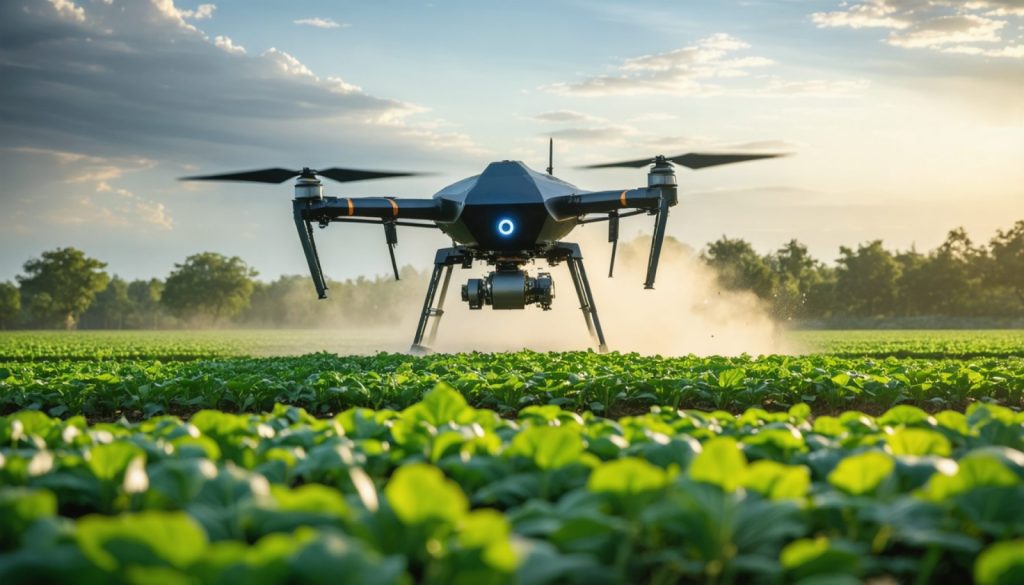
- Space technology revolutionizes agriculture by integrating satellite data, aiding farmers with precise and informed decisions.
- Satellites offer real-time insights into weather, soil, and crop health, optimizing fertilizer use and early disease detection.
- NASA’s Earth Observing System (EOS) provides critical data for precision agriculture, promoting sustainable practices.
- Combining AI with remote sensing allows for sophisticated analysis of satellite data, improving irrigation efficiency and land assessments.
- Space technology enhances sustainability and resilience in agriculture, promising efficient resource use and higher crop yields.
- Future prospects include next-gen satellite constellations offering granular data insights, ensuring food security without depleting resources.
- Space technology plays a crucial role in addressing Earth’s pressing challenges, transforming agriculture for a sustainable future.
Picture a farmer, not with soil-stained hands, but seated in a high-tech control room, managing crops with precision and clarity once unimaginable. This vision isn’t a scene from the next sci-fi blockbuster but a vivid reality made possible by advancements in space technology.
Modern agriculture faces enormous challenges—climate change, diminishing resources, and the ever-growing demand to feed billions. Here, space technology emerges as a beacon of hope, offering tools and insights to revolutionize how we grow, manage, and sustain our food sources.
Space-Based Eyes in the Sky
Satellites orbiting hundreds of miles above Earth now serve as vigilant guardians of our planet. These space-based eyes constantly capture detailed images, monitor weather patterns, and survey vast tracts of farmland. With pinpoint accuracy, farmers access real-time data to make informed decisions. Such precision allows for efficient use of fertilizers, better water management, and early detection of crop diseases.
Consider the pioneering role of NASA’s Earth Observing System (EOS). Its fleet of satellites provides critical data that fuels applications such as precision agriculture. These insights help farmers optimize crop yields, while also promoting sustainable practices.
Harnessing the Power of AI and Remote Sensing
Coupling Artificial Intelligence (AI) with space technology opens a new frontier in farming. Sophisticated algorithms parse satellite data, analyzing everything from soil moisture levels to crop health. Remote sensing technology complements these efforts by offering detailed assessments of land conditions, even in the most remote regions.
Such innovations prove invaluable in drought-prone areas, directing irrigation to where it’s needed most. As a result, farmers conserve precious water resources while ensuring crops thrive.
Transformative Impact and Future Prospects
The transformative impact of space technology extends beyond mere efficiency. By maximizing land use and reducing waste, this advanced technology promises a more sustainable and resilient agricultural landscape—one capable of meeting future food demands without exhausting our planet’s resources.
Moreover, the horizon for space technology in agriculture promises even more. As tech giants and startups invest in next-generation satellite constellations, farmers will gain access to even more granular data and unprecedented insights into ecosystem dynamics.
Takeaway Message
Space technology doesn’t just reach for the stars; it profoundly impacts our lives on Earth, revolutionizing industries and everyday activities. For agriculture, it ushers in a new era of insight, efficiency, and sustainability, ensuring that humanity can meet its growing needs without depleting our planet.
In this race against time and constraints, space technology stands as a crucial ally, showing us that the answers to some of Earth’s most pressing challenges might indeed lie beyond its skies. So the next time you enjoy a meal, remember: from afar, space technology nurtures and sustains the fields that feed us.
The Future of Farming: How Space Technology is Revolutionizing Agriculture
Expanding the Horizon: Space Technology in Agriculture
In an age where technology penetrates every aspect of life, agriculture is no exception. The implementation of space technology is reshaping traditional farming, offering innovative solutions to long-standing challenges. From precision farming aided by satellite data to AI-driven insights, these advancements are setting the stage for a new agricultural revolution.
Key Developments in Space-Aided Agriculture
1. Satellite Imaging and Crop Monitoring:
– Real-World Use Cases: Satellites provide comprehensive data on weather, soil conditions, and crop health. For example, the European Space Agency’s Sentinel satellites deliver open-access data critical for monitoring agricultural activities across the globe.
– Market Trends: According to [Research and Markets](https://www.researchandmarkets.com), the global agricultural satellite market is expected to grow significantly, driven by increasing demand for precision farming techniques.
2. The Role of Artificial Intelligence:
– AI Algorithms: By analyzing satellite data, AI can predict crop yields, assess damage from pests, and forecast weather-induced stress on agriculture. Google’s DeepMind and IBM’s Watson are examples of AI platforms contributing to agricultural productivity.
– Future Prospects: With the integration of AI, predictive analytics in farming could become as standard as weather forecasts, offering unparalleled precision in agricultural planning.
How-To: Leveraging Space Data for Farming Efficiency
Farmers can adopt space technology by partnering with tech firms specializing in agricultural solutions. Here’s a quick guide:
– Utilize Satellite Data: Access imagery from reliable sources like NASA’s EOS or commercial providers for real-time monitoring.
– Integrate AI Tools: Use AI-powered platforms to analyze satellite data, gaining insights on everything from soil moisture to potential crop diseases.
– Implement Remote Sensing: Deploy sensors on the ground to work in tandem with satellite data for a more detailed understanding of field conditions.
Pros and Cons Overview
Pros:
– Efficiency: Enhanced resource management, reducing waste in water and fertilizers.
– Scalability: Tools can be adapted for both small-scale and large-scale operations.
– Sustainability: Supports environmentally friendly practices, crucial for long-term agricultural health.
Cons:
– Cost: Initial investment in technology can be high, although costs are decreasing.
– Expertise: Requires training and knowledge to interpret data effectively.
– Privacy Concerns: The extensive use of satellite data raises potential privacy issues regarding data usage.
Industry Insights and Predictions
Security & Sustainability: With advancements in space technology, ensuring data security will be paramount. Strategies to safeguard agricultural data and promote sustainability will be in focus.
Investment Trends: Investors are increasingly looking at space technology in agriculture, forecasted to grow around 9% annually in the coming decade, according to [MarketsandMarkets](https://www.marketsandmarkets.com).
Conclusion: Actionable Tips for Farmers
– Start Small: Experiment with localized satellite data to identify areas of improvement in crop management.
– Train for Tech: Invest in training to better understand and utilize space technology.
– Stay Informed: Follow industry developments through resources like SpaceX and Blue Origin for cutting-edge advancements.
Space technology is a powerful tool that, when utilized effectively, holds the promise to address some of the most pressing challenges in agriculture today, paving the way for a more efficient and sustainable future.



